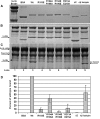Interactions between UvrA and UvrB: the role of UvrB's domain 2 in nucleotide excision repair
- PMID: 15192705
- PMCID: PMC449773
- DOI: 10.1038/sj.emboj.7600263
Interactions between UvrA and UvrB: the role of UvrB's domain 2 in nucleotide excision repair
Abstract
Nucleotide excision repair (NER) is a highly conserved DNA repair mechanism present in all kingdoms of life. UvrB is a central component of the bacterial NER system, participating in damage recognition, strand excision and repair synthesis. None of the three presently available crystal structures of UvrB has defined the structure of domain 2, which is critical for the interaction with UvrA. We have solved the crystal structure of the UvrB Y96A variant, which reveals a new fold for domain 2 and identifies highly conserved residues located on its surface. These residues are restricted to the face of UvrB important for DNA binding and may be critical for the interaction of UvrB with UvrA. We have mutated these residues to study their role in the incision reaction, formation of the pre-incision complex, destabilization of short duplex regions in DNA, binding to UvrA and ATP hydrolysis. Based on the structural and biochemical data, we conclude that domain 2 is required for a productive UvrA-UvrB interaction, which is a pre-requisite for all subsequent steps in nucleotide excision repair.
Figures








Similar articles
-
Crystal structure of UvrB, a DNA helicase adapted for nucleotide excision repair.EMBO J. 1999 Dec 15;18(24):6899-907. doi: 10.1093/emboj/18.24.6899. EMBO J. 1999. PMID: 10601012 Free PMC article.
-
Structural basis for transcription-coupled repair: the N terminus of Mfd resembles UvrB with degenerate ATPase motifs.J Mol Biol. 2006 Jan 27;355(4):675-83. doi: 10.1016/j.jmb.2005.10.033. Epub 2005 Nov 8. J Mol Biol. 2006. PMID: 16309703
-
Dynamics of the UvrABC nucleotide excision repair proteins analyzed by fluorescence resonance energy transfer.Biochemistry. 2007 Aug 7;46(31):9080-8. doi: 10.1021/bi7002235. Epub 2007 Jul 14. Biochemistry. 2007. PMID: 17630776
-
The nucleotide excision repair protein UvrB, a helicase-like enzyme with a catch.Mutat Res. 2000 Aug 30;460(3-4):277-300. doi: 10.1016/s0921-8777(00)00032-x. Mutat Res. 2000. PMID: 10946234 Review.
-
Role of ATP hydrolysis by UvrA and UvrB during nucleotide excision repair.Res Microbiol. 2001 Apr-May;152(3-4):401-9. doi: 10.1016/s0923-2508(01)01211-6. Res Microbiol. 2001. PMID: 11421287 Review.
Cited by
-
Homologous recombination but not nucleotide excision repair plays a pivotal role in tolerance of DNA-protein cross-links in mammalian cells.J Biol Chem. 2009 Oct 2;284(40):27065-76. doi: 10.1074/jbc.M109.019174. Epub 2009 Aug 11. J Biol Chem. 2009. PMID: 19674975 Free PMC article.
-
Identification of Novel Genes Mediating Survival of Salmonella on Low-Moisture Foods via Transposon Sequencing Analysis.Front Microbiol. 2020 May 15;11:726. doi: 10.3389/fmicb.2020.00726. eCollection 2020. Front Microbiol. 2020. PMID: 32499760 Free PMC article.
-
Cooperative damage recognition by UvrA and UvrB: identification of UvrA residues that mediate DNA binding.DNA Repair (Amst). 2008 Mar 1;7(3):392-404. doi: 10.1016/j.dnarep.2007.11.013. Epub 2008 Jan 11. DNA Repair (Amst). 2008. PMID: 18248777 Free PMC article.
-
A structural model for the damage-sensing complex in bacterial nucleotide excision repair.J Biol Chem. 2009 May 8;284(19):12837-44. doi: 10.1074/jbc.M900571200. Epub 2009 Mar 13. J Biol Chem. 2009. PMID: 19287003 Free PMC article.
-
An N-terminal clamp restrains the motor domains of the bacterial transcription-repair coupling factor Mfd.Nucleic Acids Res. 2009 Oct;37(18):6042-53. doi: 10.1093/nar/gkp680. Epub 2009 Aug 21. Nucleic Acids Res. 2009. PMID: 19700770 Free PMC article.
References
-
- Alexandrovich A, Czisch M, Frenkiel TA, Kelly GP, Goosen N, Moolenaar GF, Chowdhry BZ, Sanderson MR, Lane AN (2001) Solution structure, hydrodynamics and thermodynamics of the UvrB C-terminal domain. J Biomol Struct Dyn 19: 219–236 - PubMed
-
- Friedberg EC, Walker GC, Siede W (1995) DNA Repair and Mutagenesis. Washington, DC: ASM Press
-
- Goosen N, Moolenaar GF (2001) Role of ATP hydrolysis by UvrA and UvrB during nucleotide excision repair. Res Microbiol 152: 401–409 - PubMed
Publication types
MeSH terms
Substances
LinkOut - more resources
Full Text Sources

